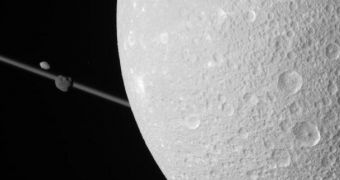The NASA Cassini spacecraft carried out a new flyby of Saturn's moon Dione on Monday, December 12. While the main science data obtained during the maneuver have yet to be compiled, researchers say that the flyby did provide some interesting new views of the Saturnine moon system.
Experts at the NASA Jet Propulsion Laboratory (JPL), in Pasadena, California – who manage the mission for the Science Mission Directorate at NASA Headquarters, in Washington, DC – say that the maneuver took Cassini within 61 mile (99 kilometers) of the small moon's surface.
One of the things that made the latest flyby so interesting is that it was the closest Cassini ever conducted around Dione. The point of closest approach between the two was reached at around 0939 GMT yesterday.
The moon was first imaged y the Voyager space probes, on their way to exit the solar system. Cassini then carried out three flybys of the object, including this one – in 2005, 2010 and 2011, respectively.
Though Dione is only about 561 kilometers (348.96 miles) wide, it is interesting to astronomers due to a large number of landscape features that have puzzled experts the first time they were revealed. These include crater chains, long and narrow depressions called fossae, ice cliffs and chasms.
During yesterday's flyby, Cassini used its composite infrared spectrometer and radio science subsystem instruments to investigate the moon. While this was the main objective of the mission, the JPL team also took some snapshots of the object and its orbital companions, as they traveled around Saturn.
In the full set of unprocessed images, the Saturnine moons Mimas, Epimetheus and Pandora also appear from time to time. Several landscape features on the surface of Dione itself are also made visible, due to the close proximity of the flyby.
The best photographs Cassini obtained during this flyby have a resolution of 350 meters (1,100 feet) per pixel, which is not very high. However, it is important to remember that no emphasis was placed on imaging the moon. High-resolution photos will be collected during a flyby scheduled for May 2012.
After having completed yesterday's flight, the NASA spacecraft is currently en route to complete a new flyby of the giant Saturnine moon Titan, which it will carry out today. However, this maneuver will only take it around 2,200 miles (3,600 kilometers) above the object's surface.
The point of closest approach will be reached at around 2011 GMT today. Titan and Enceladus – as the most interesting moons around Saturn – have been the most investigated by Cassini.
The spacecraft has been surveying Saturn, its ring systems and its moons since achieving orbital insertion around the gas giant, on July 1, 2004.

 14 DAY TRIAL //
14 DAY TRIAL //